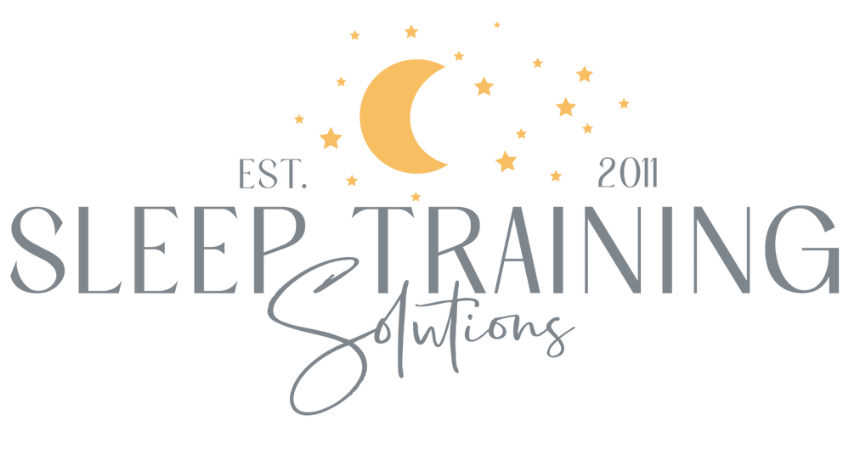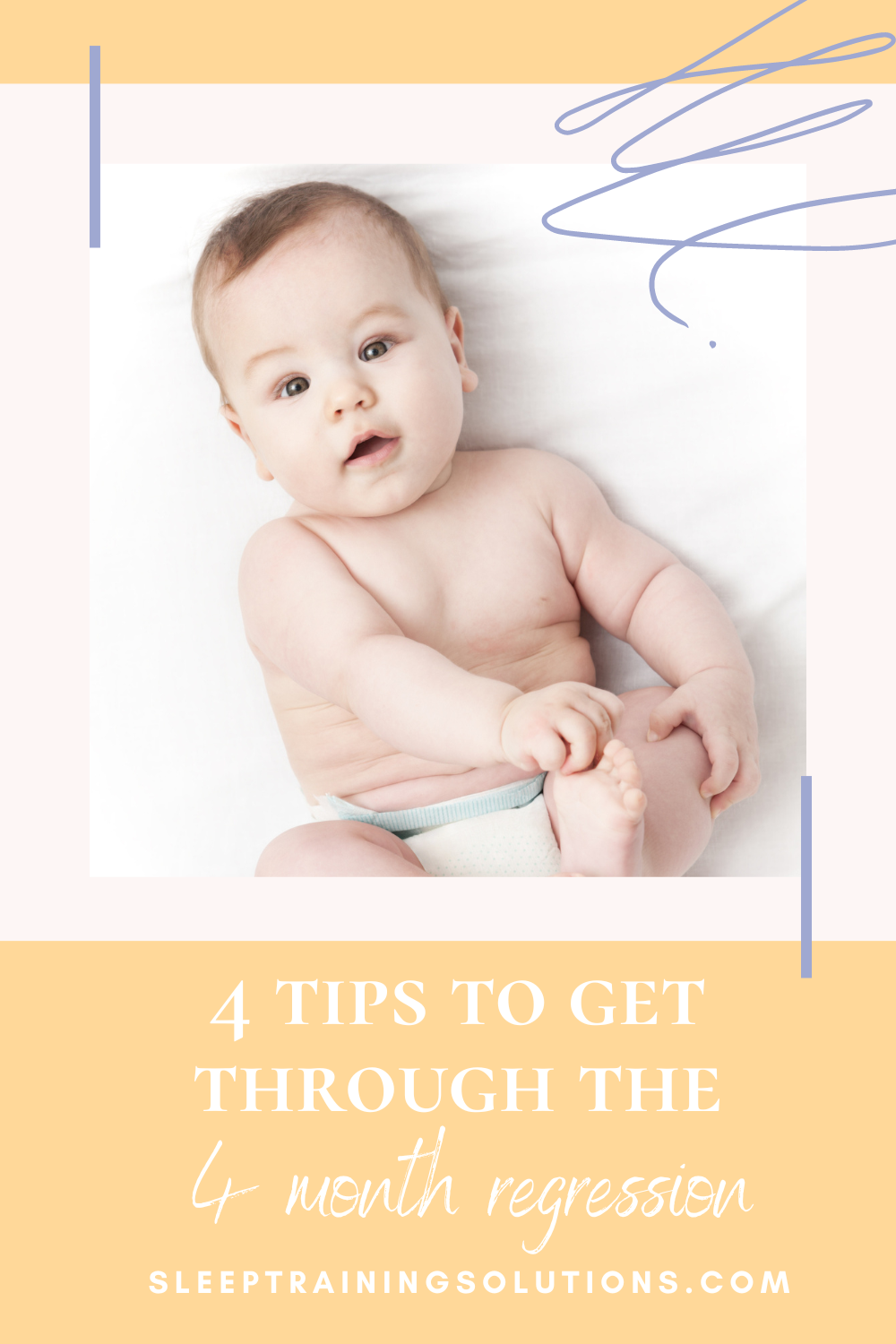4 tips to get through the 4 month regression
Ahh, the dreaded 4-month regression.
You’ve read about it in books and on blogs and heard stories from friends…and now you’re wondering what it will look like for YOUR child!
First let’s talk about why this regression can happen because it explains why, for some babies, this is more of a blip than a derailment from sleep.
Despite its name, the 4 month regression can show up anytime between 3-5 months. So if your baby’s sleep is getting worse earlier than 4 months, that’s not unusual!
Your baby is learning and developing at such a rapid rate! Here are some of the physical and mental milestones that are happening around this age:
Head control while being held
Pushing up on elbows during tummy time
Learning to roll over
Starting to sit with support
Beginning to bear weight on a hard surface
Reaches for objects
Starting solid food
Object permanance – which is why peek-a-boo becomes such a fun game at this age!
By 4 months, most babies have doubled their birth weight and are sleeping more continuous stretches of sleep. Your baby has also transitioned from newborn sleep with only two sleep cycles to four sleep cycles. And this means memory is starting to form.
If your baby has strong sleep props or associations (feeding to sleep, rocking to sleep, needing to be in a car/stroller to fall asleep, etc), this is the time when you’ll start seeing that you need to do more of these things to get the same “effect” – so instead of the 5 minutes of rocking you used to do in order to get your little one a decent length nap, you’re now rocking 45 minutes for a SHORTER nap?!
This is because your baby is making the association between the sleep prop and falling asleep and remembering that she prefers to fall asleep that way because it’s easier!
And the more she gets that sleep prop prior to sleep, the more it reinforces it and makes it very challenging for her to learn self-soothing skills to get herself into the next sleep cycle without that sleep prop. If she can’t self-soothe, then you’ll see short naps, frequent nightwakings, and early wakeups, in addition to lengthy amounts of time to get your baby down to sleep.
So what can you do to help your family get through this time?
Make sure your baby isn’t overtired
When your baby misses that window before overtiredness hits, it makes it much harder for him to fall asleep AND stay asleep. I recently worked with an almost 5 month old who was going to bed approximately an hour later than he should’ve been, so he was very overtired. He also wasn’t on the appropriate nap schedule for his body – his mom was going by the schedule she had read in a book that works for many babies, just not hers! So make sure to watch for tired signs to get your little one in bed before the overtiredness sets in!
Make sure your baby is getting the right amount of ounces each day and following EAT-PLAY-SLEEP, when possible
It’s always a good idea to check in with your pediatrician to see how many ounces per feed and/or ounces per day your baby needs. Then to help break any feed-asleep association, give your baby feeds after she wakes from a nap, not right before. If your baby’s feed is landing right before a nap, make sure it’s 15 minutes before the nap.
Remember that milk is the primary source of nutrition until the first birthday, so once you start introducing solids into her diet, make sure it’s not right before a bottle because she may get too full to drink it!
Practice practice practice for you AND your baby
Teaching him how to fall asleep for the very first time in his life without sleep props won’t happen overnight! This is a process that can take a couple of days to a couple of weeks to get consistent. The length of time it takes to “click” will depend on a few things: if you are using the right method for your baby’s temperament, you have an appropriate routine, the schedule is the right one for your baby so he doesn’t get overtired and you are being really consistent in how you address middle of the night wakings, short naps, etc and don’t cave back to the old sleep props. So in a sense, you are practicing being consistent!
Then your baby also needs to practice whatever milestone he’s currently working on! Is he just starting to roll over? Or has been rolling one way, but gets stuck going the other way? Then during most of his awake times you need to help him practice and master these new skills when he’s not IN his crib. Once that happens, falling asleep and staying asleep will be easier.
Get rid of sleep props
It sounds simple but it’ll be a process depending on how long your baby has needed them and how strong the association. I also find that the harder the baby’s temperament, the stronger they hold onto them!
One of my clients right now is a 4.5 month old little boy who had never fallen asleep on his own – he was always rocked and fed to sleep at bedtime, then put in the crib in a weighted sleep suit and a pacifier in his mouth. For naps, they put him in a swing or the stroller with his pacifier and would only sleep 20-30 minutes. He’s also has what his parents and pediatrician call a “hard baby” – he is very stubborn, strong-willed and cries easily and “forcefully”.
His mom called me when the 4 month regression hit and all his sleep props stopped working almost overnight.
When his mom and I started working together, I wrote their sleep plan to remove all five of those sleep props at the same time so it was less confusing to the baby – if you keep one sleep prop and not another, or use them inconsistenly, your baby doesn’t get the opportunity to learn self-soothing skills consistently. They actually learn much faster in my experience to do everything at once!
On Night 1 he had six wakeups – some shorter than others – but mom was consistent, was able to comfort him, but didn’t bring back any of the sleep props at 3am!
On Night 2, he fell asleep at bedtime in a third of the time from the previous night and only had two night wakings.
On Night 3, he fell asleep at bedtime in 10 minutes and only had one night waking for less than 5 minutes and self-soothed back to sleep without assistance from his parents.
We’re a week into sleep training at this point and he goes to bed easily at bedtime, sleeping 11.5-12 hours at night in a regular sleep sack in his crib, and his naps in the crib are starting to get more consistent too. Yesterday his mom actually emailed to ask if she should wake him up from his first nap after 2 hours?!
Yup, his regression is long gone now because we got rid of his sleep props, got him on the perfect schedule for naps on bedtime so he never got overtired and his mom was a rockstart in the consistency department.
Thinking about starting sleep training? Download your free PDF to help set you up for success!
Of course every baby and situation is different, but I do know this is the most important step to get your baby sleeping through the night! It can also be the hardest because there will be crying since your baby doesn’t (yet) know how to self-soothe. Many parents second-guess themselves (if they aren’t working with a sleep consultant) and give up right before the night where the breakthrough happens!
You can get through the 4 month regression, and assuming you do these 4 things, it shouldn’t last long at all! If you just ride it out and wait for the regression to pass, however, you’ll be waiting a LOOOOOONG time. Because your baby’s sleep cycles changed, this can be more of a more permanent situation with sleep associations preventing self-soothing skills from developing.
If your baby is around 4 months and the sleep props are losing their effectiveness, then you’re starting the regression. If you need expert guidance to get through it quickly so this time next week everyone is getting more sleep, please take the first step and let’s talk!
Related Posts:
This post is for informational purposes only and may not be the best fit for you, your child and/or your personal situation. It shall not be construed as medical advice. The information and education provided here is not intended or implied to supplement or replace professional medical treatment, advice, and/or diagnosis. Always check with your child’s physician or medical professional before trying or implementing any information read here.






